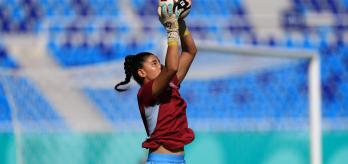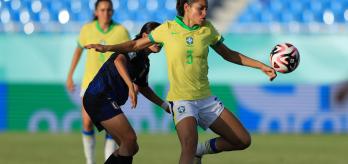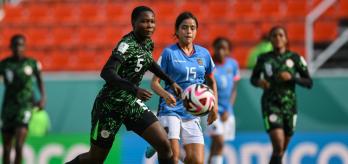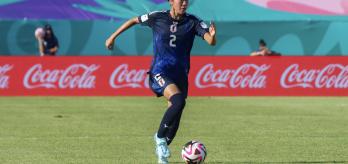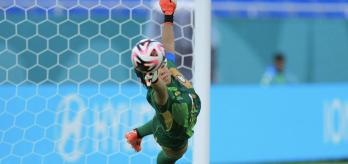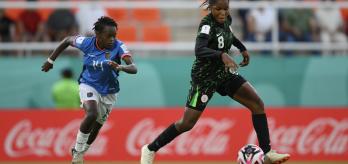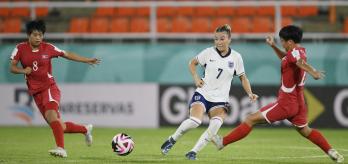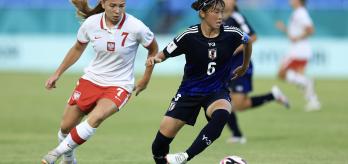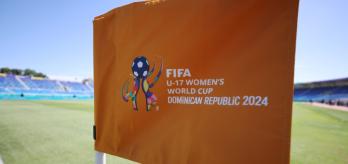Specifically, the use of the low cut-back and driven crosses in addition to low push passes were verified by our Football Performance Insights team as leading to higher value chances, and in this article, our TSG explore the reasons why these types of crosses were so effective and deliberately chosen.
Chances created from different variations
Our analysis of the data relating to push, cut-back and driven crosses/passes from open play across the penalty area towards the central zone revealed that 24% of attempts at goal from these actions were converted goals, 14% more than the conversion rate for all attempts at goal (10%). In total, 308 of these types of low passes/crosses across the penalty area were executed, with 46 attempts at goal coming directly from those passes/crosses, and 11 goals were scored.
Tournament winners, Korea DPR, used these passes/crosses most, registering a total of 47, leading directly to eight attempts at goal and resulting in two goals. Runners-up Spain generated even more success in this way, playing 42 of these passes/crosses, leading to 11 attempts at goal and resulting in four goals.
According to TSG member Vanessa Bernauer, “In creating these attacking situations, these young players showed high levels of game intelligence, and an awareness of their roles and responsibilities. When in the final third, they were clever to recognise that their centre-forward might not be ready or in position for a high cross, or that the attacking setup was incomplete, but could recognise incoming runners and made decisions to cross based on the picture they could see and the attacking options available. They understood when to keep the ball until the advancing player was arriving instead of playing hopeful balls across the area. Furthermore, they understood the implications of the body shape of defenders who were facing the ball in the wide areas and less aware of the incoming threats.
“They were less wasteful and had more intention about what they were doing, and the quality of the deliveries was high. Incoming players also expected the cut-back crosses and were making explosive, committed runs to arrive into the space between the lines of the opposition’s defence. Players arriving into the penalty area also showed great composure and good technique by being able to take on first touch attempts at goal, with either foot, without breaking their stride,” she added.
Goals from cut-back crosses
In clip 1, we see a great example of a goal being scored from a cut-back cross. As England build their play, Mexico are attempting to hold a high line, but as soon as right centre-back Zara Shaw (5) plays the long pass into the space behind Mexico’s defensive line, the orientation of the recovering defenders changes towards their own goal. Right-back Nelly Las (2) is aware that her teammate Rachel Maltby (3) is making an attacking run inside the penalty area and plays a first-time cut-back cross. Crucially, as Las plays the ball across, Maltby checks her run as she approaches the goal area, meaning the momentum of the recovering defender takes her away from the attacker as she scores with a first-time finish.
Then, in clip 2, we see another goal from a cut-back cross, again with a first-touch finish. Korea DPR have an attacking throw-in in the final third, and Choe Il-son (15) gets on the ball and drives to the byline under pressure. With no option available to drive the ball across the goal, she cuts it back towards the edge of the goal area (six-yard box) to (11) Choe Rim-jong (11), who arrives unmarked after the nearest defender opts to defend the space at the back post.
Goals from push pass
In clip 3, we see a superb goal from the USA that comes from a driven pass inside the penalty area to a runner from deep following a well-constructed attacking phase. As the USA defenders build play using their deep-lying central midfielder, Kennedy Fuller (10), their wide forward, Mel Barcenas (13), is in a narrow position to keep Korea DPR’s right-back pinned in with her back four. This allows the USA left-back Jocelyn Travers (2) to push high and receive the ball in space. The pass to Travers triggers a diagonal run into the left channel from Barcenas, and this in turn triggers a straight (untracked) attacking run towards the penalty area by midfielder, Fuller. Barcenas has four defending players in her vicinity, leaving a gap behind them and works extremely hard, and consciously to keep the ball until she can play a perfectly timed push pass into that space to the oncoming Fuller, who scores from a tight angle with her first touch. It should be noted that Barcenas had options at the back post, but she consciously worked to create this high value scoring chance.
Goals from driven pass
Finally, in clip 4, we see another high value goalscoring opportunity converted as Korea DPR score using a driven pass in the final third following a long pass forward that breaks England’s defensive line. As forward Choe Il-son (15) receives the ball, it triggers explosive forward runs from a number of supporting players. She works hard to hold onto the ball until the support arrives before releasing to wide left midfielder Jon Il-chong (7) in the left channel. With her second touch, she drives a low, dangerous cross into the penalty area behind England’s retreating defensive line, picking out the run of forward Kang Ryu-mi (12), who is facing the goal as she splits two defenders and scores with her first touch. The pace and timing of the driven cross is an important factor here, as that favours the attacking player whose clever run takes her across the front of the left centre-back, taking her out of the game.
Key take-aways
- Recognising where the opportunity is and intentionally creating the scenario before playing the pass/cross, instead of playing hopeful balls across the goal
- Targeting space between the opponent’s defensive lines in the penalty area
- Low deliveries into space with pace and accuracy
- Staggered/untracked runners into these spaces for first time attempts at goal
- Capitalising on defensive players orientated towards the origin of the pass as opposed to defending the incoming player
- Attacking players competent on both feet to strike the ball at goal with their first touch







